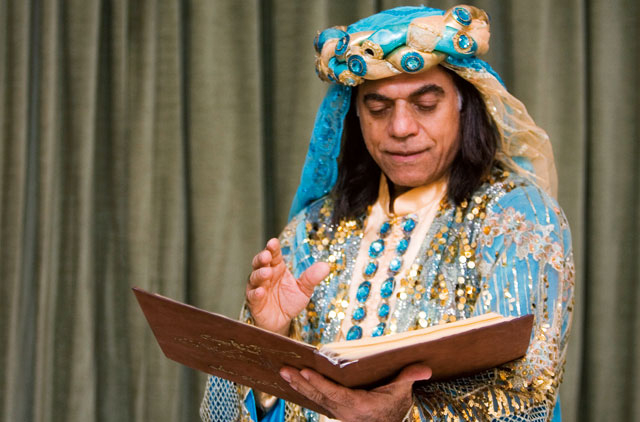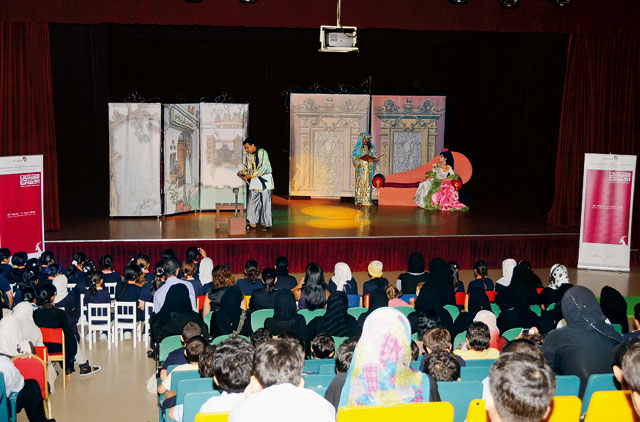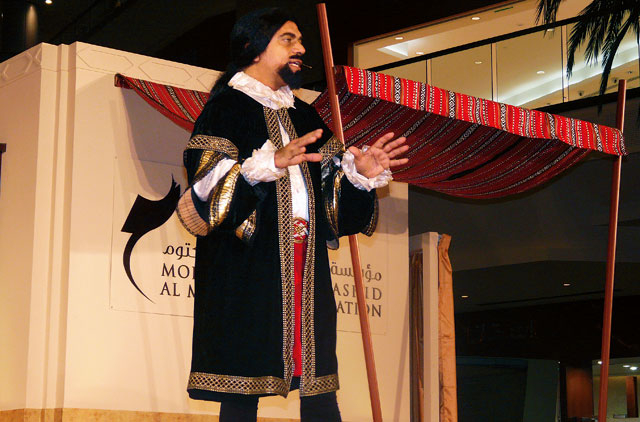For centuries the Arabian Peninsula and the Middle East region have been the sources of legends, fables and tales of the adventures of kings and warriors. For generations, the tradition of oral storytelling was a powerful medium for narrating the drama inherent in these tales and breathing life into them.
The storyteller who represented the collective genius and fantasies of his people would, with his way with words, spin yarns and breathe life into the heroes of history, fables from the Quran and legends and myths about warriors - bringing a piece of the past to life for his avid listeners.
Tales within tales
One of the most revered traditions of oral storytelling is the hakawati. As intricate and complex as a weaving pattern, this motif-rich narrative style darts in and out of stories, offering unending drama where the storyteller begins one tale, deftly leaves it mid-way to pick up another and then has a third story emerging from a subplot of the first and so on. All this is done using the tools of allegory, folklore, satire, music and a visual spectacle of grand sweeping gestures and facial expressions to finally create an enthralling experience for his listeners.
Hakawati was one of the most riveting leisure activities for people and their neighbourhoods in a bygone era when cinema or television did not exist. Entertainment derived from simple means - like a man telling a story that was compellingly attractive to pass the time and learn a few morality lessons along the way - was a powerful way of making people step out of their everyday concerns and willingly lose themselves in another world.
The origins of the word hakawati lie in the terms hekaye and haki. Hekaye in Arabic means the story and haki means to talk. The one who talked and told a story was a hakawati. The storytellers would use the device to enable people to vent their unexpressed anger, joy, grief and angst as the minutes stretched out and encircled them in a world that loosened the fetters of daily vexing issues and provided them supple moments of vicarious participation in tales of heroism and valour.
It was this irresistible pull that gave hakawati its appeal.
However, as the world moved towards modernity and technology, this age-old tradition found itself being sidelined by the more pushy and aggressive forms of capturing people's interest and imagination. The hakawati began to find himself at the margins, and the tales of valour, nobility and generosity, though just as fascinating as ever, were not finding takers as they once did.
But all is not lost yet. This rich and beautiful thread of heritage in the fabric of the region, though a bit frayed, is now fortunately being strengthened once again.
Ever since the Lebanese-American painter-writer, Rabih Alameddine wrote his book The Hakawati (published in the US in 2008) which won critical acclaim around the world, this rich Arabic tradition of storytelling has drawn great interest globally.
In the UAE, a cultural revival of folklore and other folk arts is under way and hakawati has been happily rediscovered. The tradition is now moving away from the margins and making its way to back to the centrestage. From Beirut to Damascus to Cairo to Dubai, Abu Dhabi and Sharjah ... the hakawati is now reclaiming his pride of place. Once again, he is a crowd-puller. Once again his audiences are loving the colour, sound and fury of the tales as narrated by him. Yes, the tribe is a small one at the moment but it is not going to remain as such if the current revival is any indication.
Reviving Hakawati
Abu Dhabi, circa 2010. It was a live theatre experience, a unique show that transported the audience in a packed auditorium to a time in Arabia when Sindbad ruled the seas and Scheherazade was the queen of narrative holding King Shahryar's imagination captive with her unending stream of enchanting tales.
For those few hours, as they watched the spectacle of narration on the stage, the audience could well have been sitting in a village square under a ghaf tree a hundred years back. The man at the centre of the stage was bringing to life some of the most interesting tales from 1,001 Nights.
Adventure, love, betrayal, action and the final happy denouement... the audiences lapped up the timeless elements of a tale. The story teller, experimenting with pitch, tone and accent, effortlessly got under the skin of the many characters he was assaying.
The man was Ahmad Yousuf, an intrepid artist, actor and hakawati storyteller, perhaps the only one in the UAE, who has revived this ancient art in keeping with the upsurge of interest in it.
Yousuf, an instinctive actor who loves the theatre, works in the IT department of the Sharjah government and dedicates all his spare time to honing his craft. You can find him in the evenings at the Sharjah National Theatre, rehearsing with his troupe of 20 artists, reinterpreting classics, adding pith to sketchy fables, borrowing the power of music and dance to reinforce the emotions of love and happiness. He along with his troupe gives performances all over the UAE and has been invited to many other countries such as Syria, Greece, Tunisia, Egypt and Romania.
Friday caught up with Yousuf to understand what made him want to revive this art form.
"I did not have the good fortune to experience hakawati storytelling as a child," says Yousuf. "But my family was greatly interested in theatre and cinema. We often went to watch movies. Even as a child, I was hooked on cinema and fell in love with the celluloid world, the drama of it all, the beautiful actors and actresses.
"I secretly desired to be an actor," he says. When he grew up, he began doing theatre in Cairo and has been associated with theatre for more than 22 years now. "Working in theatre helped me grasp the subtleties of a performance, how hard it was to connect with the audience, find a good story to perform and find good artists who could live those roles. I also learnt a lot about costumes, the flow of scenes, etc," recalls Yousuf about his days in Cairo.
Discovering the art of storytelling
Nine years ago, he moved to Sharjah to work in the IT department of a government organisation. He was keen to pursue his art in the evenings and immediately enlisted at the Sharjah National Theatre. Yousuf was passionate about theatre and wanted to do something that would enrich the cultural fabric of society.
"My mentor here was Qasim Mohammad who was the director of the Sharjah National Theatre. He suggested that since I had a good voice, I could narrate stories. He taught me how to modify my voice, how to pick a pause at the right time, master the right intonations and provide the complete effect for the story so that the audience would feel as though there was not one but many people doing the act."
Yousuf feels the time has come for the art of storytelling to enjoy a renewed lease of life. "Storytellers have always been a part of the Arabian ethos and have been very popular with people," says Yousuf. "In fact it was said that after the ruler of the country it was the storyteller who occupied the second most important position as telling a story involved communicating with the masses. Kings, too, depended on storytellers to spread their message. When I discovered the storyteller in me I immediately began doing small projects like reading out stories to children in malls. The children I realised were hungry for good tales." The realisation pushed Yousuf to do more research for his craft. "The richest source for me was the Holy Quran, which has many fables that people know and yet want to hear over and over again."
The importance of allegory
The Quran is a priceless source of allegorical tales that are simple, yet engaging, and talk of simple gem-like truths of life such as the triumph of good over evil, the importance of being humble and generous and helping the poor, among many other timeless truths.
Yousuf talks about one particular tale he narrates a lot: a poor man who is pure at heart, after experiencing many trials and tribulations in life, stumbles upon a great fortune. A greedy rich man, who is wicked at heart, learns of this and tries to follow in his footsteps in pursuit of the wealth. The result is he is struck by a severe blow of misfortune.
Yousuf sees a clear message in tales such as these. "You get only what the Almighty plans to give you."
With his passion having found its niche, Yousuf turned his attention to extending his skills to special needs children. As his work grew more popular (he has been a hakawati artist for six years now), Yousuf decided that his art now needed to be extended to other age groups as well. Unsurprisingly, he realised that even adults loved to listen to a hakawati. An observation that impacted his mind during his sessions with children when he found the adults accompanying them to be equally rapt in his narration.
The five important elements of hakawati
- For a hakawati artist, the following are the five most important aspects to be kept in mind, says Yousuf:
- The narrative: Every story selected should have a strong plot that captures the interest of listeners.
- The characters: There must be a minimum of three to four characters in the story who interact and move the story towards its climax.
- The action: The story must have sound and fury - a clash of kings, an adventure on high seas or a quest for something that is undertaken over a vast expanse of sand dunes. The sweep of the story and its setting is what engages the listener.
- The spectacle: This includes music, soundtrack and colours that work as symbols. For example, blue to represent the sea or yellow to represent the sand or sun. The spectacle helps the audience to be lead willingly into the thick of the tale.
- The message: Stories must act as an important community service and the storyteller must shoulder the responsibility of communicating the importance of living a principled life to the people at large.
Storytelling as a tool for change
Not content with narrating tales drawn from the past, Yousuf has begun writing his own dramatised versions from history. Last year, he wrote Al Jawhara, a tale set in the history of the UAE in 1509 during the invasion by the Portuguese General Alfonso De Albuquerque. The story about the devastation caused by the invasion was narrated by him along with about 25 other artists from the Al Thiqah Club for the Handicapped from Sharjah.
He found the experience to be deeply enriching as he watched his physically challenged fellow narrators display their extraordinary dedication and sincerity. "It was really therapeutic for them. I think storytelling is an art that has to revived and preserved for future generations. It ought to be included in the school and college curriculums."
A thought seconded by Huda Khamis Kanoo, the founder of the Abu Dhabi Music and Art Foundation (Admaf). Kanoo has been at the forefront in the effort to revive the hakawati tradition. Last month when Yousuf performed a series of interesting vignettes at Admaf for Abu Dhabi University to welcome new students, Huda said: "The new wave of students at Abu Dhabi University represents the future. We applaud their commitment to learning and hope that the arts will help them broaden their minds, think creatively and enhance their academic performance. Just as we look to the future, so should we remember the past; and what better way to do so than through our own customs and traditions?
"Through events like this, we are inspiring the next generation of Emiratis to appreciate and engage with their heritage."














